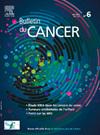[评论:新的碳酸酐酶ix靶向探针用于成像缺氧肿瘤]。
IF 1.1
4区 医学
Q4 ONCOLOGY
引用次数: 0
摘要
2023年,《生物偶联化学》(Bioconjugate Chemistry)和《传感器与致动器B:化学》(Sensors and Actuators B: Chemical)期刊发表了两篇论文,描述了用于成像肿瘤缺氧区域的新型生物传感器。Cao等人将乙酰唑胺(AZA)与两个酪氨酸衍生的Mn(II)-乙二胺四乙酸螯合物(TyEDTA)结合在刚性三嗪(TA)支架上靶向碳酸酐酶IX (CA IX)。该合成的目的是制造一种基于Mn(II)的磁共振成像探针,命名为AZA-TA-Mn。在小鼠食管鳞状细胞癌缺氧模型中,低剂量0.05mmol/kg的AZA-TA-Mn比非特异性的gd -二乙烯三胺五乙酸(0.1mmol/kg)产生选择性的造影剂增强。一项涉及游离AZA和基于Mn(II)的磁共振成像探针共同注射的竞争研究证实了AZA- ta -Mn的体内肿瘤选择性。组织切片免疫荧光染色证实AZA-TA-Mn的肿瘤积累与AC IX过表达呈正相关。Cao等人使用CA IX作为缺氧的生物标志物,因此阐明了一种实用的策略,用于开发针对感兴趣肿瘤中特定缺氧区域的新型成像探针。本文章由计算机程序翻译,如有差异,请以英文原文为准。
Un commentaire : nouvelles sondes ciblées sur l’anhydrase carbonique IX pour l’imagerie des tumeurs hypoxiques
En 2023, les revues « Bioconjugate Chemistry » et « Sensors and Actuators B: Chemical » ont publié deux articles décrivant de nouveaux biosenseurs pour l’imagerie des régions hypoxiques dans les tumeurs. Cao et al. ont associé de l’acétazolamide (AZA) afin de cibler l’anhydrase carbonique IX (AC IX) à deux chélates de Mn(II)-acide éthylènediaminetétraacétique dérivés de la tyrosine (TyEDTA), sur une structure rigide de triazine (TA). L’objectif de cette synthèse était de créer une sonde d’imagerie par résonance magnétique à base de Mn(II) nommée AZA-TA-Mn. Dans un modèle murin d’hypoxie du carcinome épidermoïde de l’œsophage, l’AZA-TA-Mn, à une faible dose de 0,05 mmol/kg, a produit un renforcement sélectif du contraste par rapport à l’acide Gd-diéthylénétriaminepentaacétique non spécifique (0,1 mmol/kg). Une étude de compétition portant sur la co-injection d’AZA libre et de sonde d’imagerie moléculaire par résonance magnétique à base de Mn(II) a confirmé la sélectivité tumorale in vivo de l’AZA-TA-Mn. La coloration par immunofluorescence de coupes de tissus a confirmé la corrélation positive entre l’accumulation tumorale d’AZA-TA-Mn et la surexpression de l’AC IX. En utilisant l’AC IX comme biomarqueur de l’hypoxie, Cao et al. ont donc illustré une stratégie pratique pour le développement de nouvelles sondes d’imagerie pour les régions spécifiques d’hypoxie dans une tumeur d’intérêt.
In 2023, the journals “Bioconjugate Chemistry” and “Sensors and Actuators B: Chemical” published two papers describing new biosensors for imaging hypoxic regions in tumors. Cao et al. combined acetazolamide (AZA) to target carbonic anhydrase IX (CA IX) with two tyrosine-derived Mn(II)-ethylenediaminetetraacetic acid chelates (TyEDTA) on a rigid triazine (TA) scaffold. The aim of this synthesis was to create a Mn(II)-based magnetic resonance imaging probe named AZA-TA-Mn. In a murine hypoxia model of esophageal squamous cell carcinoma, AZA-TA-Mn, at a low dose of 0.05 mmol/kg, produced selective contrast enhancement over non-specific Gd-diethylenetriaminepentaacetic acid (0.1 mmol/kg). A competition study involving the co-injection of free AZA and a Mn(II)-based magnetic resonance imaging probe confirmed the in vivo tumor selectivity of AZA-TA-Mn. Immunofluorescence staining of tissue sections confirmed the positive correlation between tumor accumulation of AZA-TA-Mn and overexpression of AC IX. Using CA IX as a biomarker of hypoxia, Cao et al. have thus illustrated a practical strategy for the development of novel imaging probes for specific regions of hypoxia in a tumor of interest.
求助全文
通过发布文献求助,成功后即可免费获取论文全文。
去求助
来源期刊

Bulletin Du Cancer
医学-肿瘤学
CiteScore
1.90
自引率
16.70%
发文量
224
审稿时长
37 days
期刊介绍:
Without doubt, the ''Bulletin du Cancer'' is the French language publication of reference in the field of cancerology. Official organ of the French Society of Cancer, this journal covers all the information available, whether in the form of original articles or review articles, but also clinical cases and letters to the editor, including various disciplines as onco-hematology, solids tumors, medical oncology, pharmacology, epidemiology, biology as well as fundamental research in cancerology. The journal proposes a clinical and therapeutic approach of high scientific standard and regular updates in knowledge are thus made possible. Articles can be submitted in French or English.
 求助内容:
求助内容: 应助结果提醒方式:
应助结果提醒方式:


